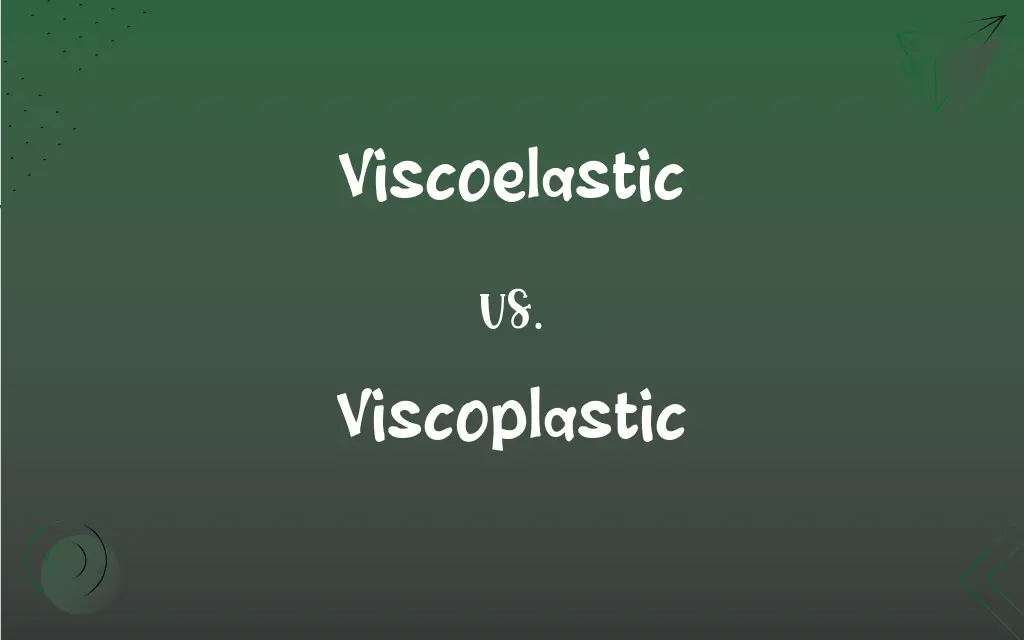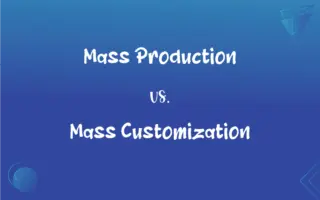Viscoelastic vs. Viscoplastic: What's the Difference?
Edited by Aimie Carlson || By Harlon Moss || Published on January 22, 2024
Viscoelastic describes materials that exhibit both viscous and elastic characteristics when deformed. Viscoplastic refers to materials that exhibit permanent deformation under stress after a certain yield point.

Key Differences
Viscoelastic materials combine viscosity and elasticity, allowing them to absorb energy and return to their original shape after stress removal. Viscoplastic materials, however, undergo irreversible deformation when the applied stress exceeds their yield point.
In viscoelasticity, deformation depends on both time and the stress applied, showing a delayed response to applied forces. Viscoplasticity is characterized by a permanent deformation that does not fully recover even after the stress is removed.
Viscoelastic materials, such as some polymers and biological tissues, display both fluid and solid characteristics. Viscoplastic materials, like many metals and plastics, behave as solids until a critical stress is applied, leading to a flow-like behavior.
The behavior of viscoelastic materials can be temperature-dependent, altering between more elastic or viscous states. Viscoplastic materials have a yield stress level; below this, they behave elastically, and above it, they flow plastically.
Viscoelasticity is useful in applications where energy absorption and dissipation are needed, like in shock absorbers. Viscoplasticity is significant in shaping and forming processes where permanent deformation is required, like in metal forging.
ADVERTISEMENT
Comparison Chart
Deformation Characteristics
Temporary and reversible
Permanent and irreversible
Response to Stress
Delayed elastic response; dependent on time and stress
Permanent deformation beyond yield stress
Material Examples
Polymers, biological tissues
Metals, certain plastics
Behavior Under Temperature
Can vary between more elastic or viscous
Consistent until yield point is reached
Applications
Energy absorption (e.g., shock absorbers)
Material shaping (e.g., metal forging)
ADVERTISEMENT
Viscoelastic and Viscoplastic Definitions
Viscoelastic
Viscoelastic materials exhibit both viscous and elastic properties.
Memory foam is viscoelastic, slowly returning to its original shape after being compressed.
Viscoplastic
Viscoplasticity is typical in metals and some plastics.
Plastics used in injection molding are often viscoplastic.
Viscoelastic
Viscoelastic materials can absorb and dissipate energy.
Viscoelastic dampers are used in buildings for shock absorption.
Viscoplastic
Viscoplastic materials undergo permanent deformation beyond a yield point.
When clay is molded, its viscoplastic nature keeps the new shape.
Viscoelastic
They have a time-dependent response to applied stress.
Silicone rubber demonstrates viscoelastic behavior under different loading conditions.
Viscoplastic
They exhibit both solid-like and flow-like behavior under stress.
Metal during forging shows viscoplastic characteristics.
Viscoelastic
Viscoelasticity is common in polymers and biological tissues.
Human tendons are viscoelastic, providing both flexibility and support.
Viscoplastic
Viscoplasticity is crucial in material forming and shaping.
The bending of steel beams in construction relies on their viscoplastic properties.
Viscoelastic
Their behavior can change with temperature variations.
Car tires, made of viscoelastic materials, behave differently in hot and cold weather.
Viscoplastic
These materials have a defined yield stress.
The deformation of copper pipes under high pressure is a viscoplastic process.
Viscoelastic
Viscous and elastic.
Viscoplastic
Describing a material that behaves as a solid below a critical value of stress, but flows like a viscous liquid at greater values of stress.
Viscoelastic
Such a material
Viscoelastic
Having viscous as well as elastic properties
FAQs
What are examples of viscoelastic materials?
Polymers like memory foam and biological tissues.
What is a viscoplastic material?
A material that undergoes permanent deformation beyond a certain stress level.
What defines a viscoelastic material?
Its ability to exhibit both viscous and elastic characteristics.
Can viscoelastic materials fully recover after deformation?
Yes, they can return to their original shape after stress removal.
Why are viscoplastic materials important in metal forging?
They allow for permanent shaping of the metal.
Can viscoelastic materials be both solid and fluid?
Yes, they exhibit properties of both states.
How does temperature affect viscoelastic materials?
It can change their behavior from more elastic to more viscous.
Do viscoplastic materials always flow when stressed?
Only when the stress exceeds their yield stress.
Do viscoplastic materials recover their shape after deformation?
No, they undergo irreversible deformation.
Are viscoelastic materials used in shock absorbers?
Yes, due to their energy absorption and dissipation properties.
What are some viscoplastic materials?
Metals and certain types of plastics.
Is there a yield point in viscoplastic materials?
Yes, they behave elastically below and flow plastically above this point.
What is a common application of viscoelastic materials?
In vibration damping and noise reduction systems.
Are viscoelastic properties time-dependent?
Yes, they show a delayed response to applied stress.
Is viscoelasticity relevant in medical applications?
Yes, especially in prosthetics and tissue engineering.
Are both viscoelastic and viscoplastic materials used in the automotive industry?
Yes, in different components for their respective properties.
Can viscoplastic behavior be reversed?
No, the deformation is permanent.
How do viscoplastic materials behave under low stress?
They behave like elastic solids.
What distinguishes viscoplastic materials in manufacturing?
Their ability to be permanently shaped under specific conditions.
Does temperature impact the behavior of viscoplastic materials?
It can affect their flow and deformation properties.
About Author
Written by
Harlon MossHarlon is a seasoned quality moderator and accomplished content writer for Difference Wiki. An alumnus of the prestigious University of California, he earned his degree in Computer Science. Leveraging his academic background, Harlon brings a meticulous and informed perspective to his work, ensuring content accuracy and excellence.
Edited by
Aimie CarlsonAimie Carlson, holding a master's degree in English literature, is a fervent English language enthusiast. She lends her writing talents to Difference Wiki, a prominent website that specializes in comparisons, offering readers insightful analyses that both captivate and inform.







































































